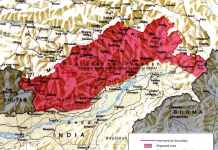As India-China conflict lingers and winters approaching, Indian army’s specialisation in high altitude warfare, some of which has also come from being stationed at world’s highest battlefield in Siachen, is expected to give a tough fight to the Chinese soldiers stationed along the LAC in Ladakh.
Indian vs Chinese Tanks: Why Mighty T-90 Tanks Have No Answer To Chinese Type-15 Lightweight Tanks?

After the violent clash between Indian and Chinese soldiers the LAC in eastern Ladakh last month, constant efforts are being made by India and China to disengage at the border through military and diplomatic channels, unsuccessfully.
As quoted by Hindustan Times, the military commanders said that the adverse weather conditions, including up to seven feet of snow, could put the Chinese at a disadvantage because its army in Akasi Chin is largely made of conscripts, who were drafted for a three-month annual summer exercise in Tibet and Xinjiang in return for the state taking care of their future education.
The Chinese PLA troops are used to moving on armoured carriers in contrast to their Indian counterparts who not only patrol on foot but live in the worst of weather conditions whether in Siachen or in Sikkim or in Thag La ridge in Tawang, the commanders added.
The Indian Army has earlier proved its might during the 1999 Kargil war where it fought from heights of Muskoh to Chorbat La in the Gilgit Baltistan area. Additionally, the Indian troops are stationed in the harshest of conditions since 1984 in Siachen, Kashmir and North-east mountain theatre, the commanders pointed out.
However, the PLA isn’t prepared to stand such adverse conditions. According to the survivors of the June 15 clash, a large number of Chinese PLA troops came in an armoured personnel carrier and soon started dropping down due to lack of oxygen at 16,000 feet when the fisticuffs began between the two armies.
Indian vs Chinese Tanks: Why Mighty T-90 Tanks Have No Answer To Chinese Type-15 Lightweight Tanks?
If the lack of oxygen did not get them, then the frozen Galwan river did the job. The PLA has not revealed the number of casualties, yet the commander added that these are more and not less than that suffered by the Indian side which loses 20 soldiers.
“Throughout the intervening night of June 15 and 16, two Chinese PLA helicopters carted the dead and injured to nearby hospitals or to hyperbaric chambers”.
Former Lt. Gen. P.J.S. Pannu holds a similar view. He said that even though the snow levels are comparatively more and the areas are hilly, the Indian Army is better equipped to sustain in such high-altitude areas having an advantage over the PLA. “Mountains favour the defender… our troops are located on high ranges,” he added in an interview to ThePrint.
The disengagement process has been slow and is expected to go on for some time with winter-ready to move into the theatre next month and firmly set in September. It is not the temperature that will kill but the wind which increases the chill factor.
Add to this the rarefied atmosphere at Galwan, Gogra-Hot Springs and the weather takes a turn for the worse,” said a senior military commander.
India’s 5th Generation Fighter Jet ‘AMCA’ Under Speedy Development – Reports
Analysts have pointed out that the Chinese PLA will soon have to decide whether to continue the aggression and spend the nights on the Tibetan plateau where temperatures of 25 degrees below zero are normal or to restore status quo.
“The other issue that the PLA will also have to keep in mind is that the Indian Army is deployed all along the 3488 km long LAC between the two countries, while the PLA is only deployed in selected places. This includes Sikkim, where the Indian Army surrounds the Chumbi Valley from three sides,” the analysts added hinting at a possible counter-aggression.




